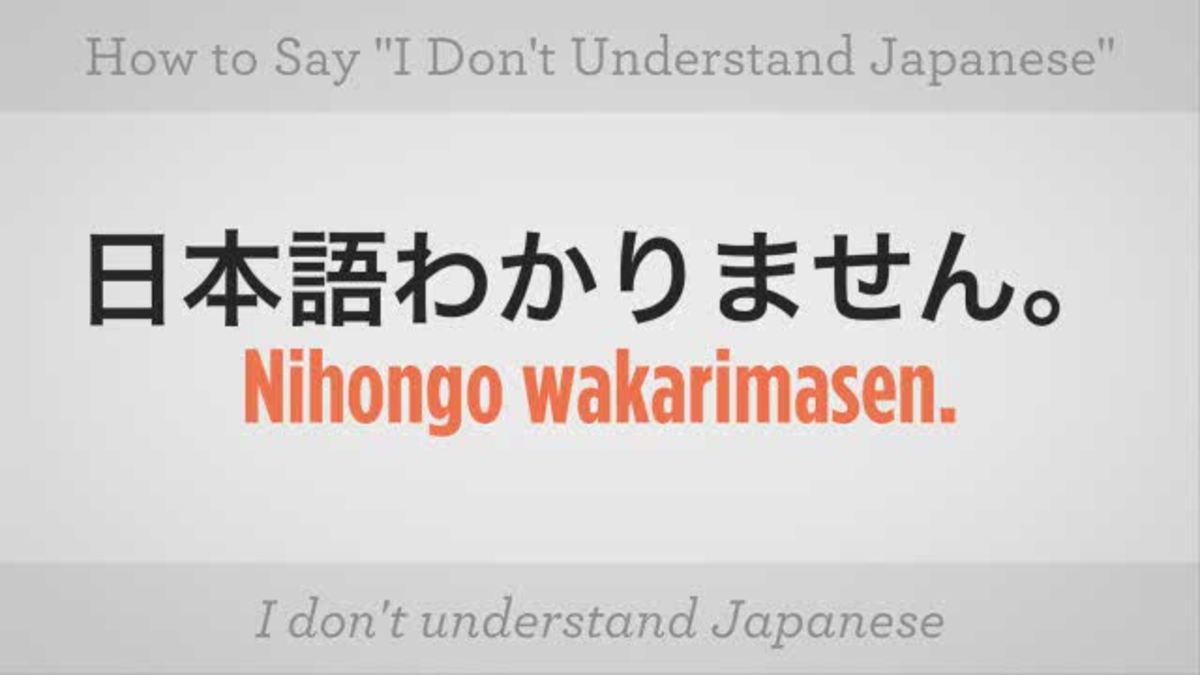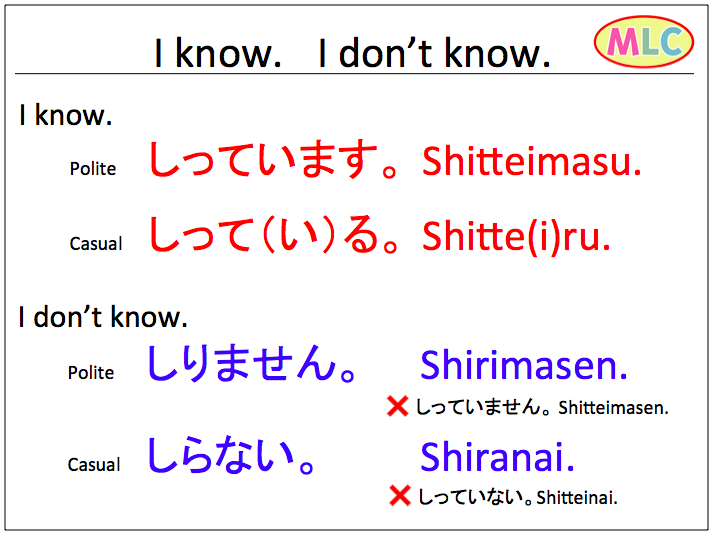Japanese For "I Don't Understand": Learn & Practice Now!
Are you struggling to communicate in Japanese, feeling lost in translation? Understanding how to express "I don't understand" is a fundamental step in your language learning journey, unlocking the ability to navigate conversations and seek clarification.
The ability to convey your lack of comprehension isn't merely about knowing the right words; it's about fostering effective communication and demonstrating a willingness to learn. In the realm of Japanese, this is particularly important, as the language is steeped in nuances of politeness and indirect expression. Knowing how to gracefully admit you don't understand allows you to respectfully request further explanation and deepen your understanding.
Let's delve into the various ways to express "I don't understand" in Japanese, exploring the subtleties of each phrase and how they fit into different contexts. This journey will not only equip you with essential vocabulary but also enhance your understanding of Japanese communication styles.
One of the most common and straightforward ways to say "I don't understand" in Japanese is "" (wakarimasen). This is a polite and versatile expression suitable for a wide range of situations. It is the equivalent of saying "I don't understand" or "I don't get it." "Wakarimasen" is a go-to phrase when you're unsure about something you've heard or read. The verb "wakaru" () means "to understand," and the "-masen" ending is the polite negative form.
There are situations where you need to express a stronger degree of not understanding. This might involve a more complex concept or information. In those instances, you could employ phrases like "" (yoku wakarimasen), which translates to "I don't understand well." The addition of "yoku" (), meaning "well" or "thoroughly," emphasizes your confusion, signaling that you're not just a little lost but genuinely struggling to grasp the matter.
In certain cases, you'll want to be more specific about what you don't understand. Suppose someone uses a word you're unfamiliar with. You could say, "" (kono kotoba ga wakarimasen), which means "I don't understand this word." Adding "kono kotoba" (this word) clarifies the source of your confusion.
- Kenny Smiths Spouses A Look At Dawn Reavis Gwendolyn Osborne
- Love Island 2024 Cast Ages Updates What We Know So Far
If you're unsure about a whole sentence or a concept, you can use phrases like "" (imi ga wakarimasen), which translates to "I don't understand the meaning." "Imi" () means "meaning," so this phrase is a direct way of stating that you don't grasp the intent behind the speaker's words.
When engaging with Japanese speakers, the tone and context are crucial. Using "" (wakannai) is a more informal and casual way of saying "I don't understand." However, keep in mind that you should only use this with friends or those you know well. In formal settings, it would be considered impolite.
Beyond basic phrases, knowing the nuances of the Japanese language can help you navigate conversations more effectively. For example, the sentence structure in Japanese is often different from that in English. The Japanese language frequently places the verb at the end of a sentence. This can sometimes make it challenging for learners to follow along, especially when processing information in real-time.
In addition to the various ways of expressing "I don't understand," it's also valuable to learn related phrases. One such phrase is "" (mou ichido itte kudasai), which means "Please say it again." Its a polite way of asking someone to repeat something you didn't understand the first time. Another helpful phrase is "" (yukkuri hanashite kudasai), which translates to "Please speak slowly." This is useful when the speaker is talking too fast.
Learning to express "I don't understand" is a cornerstone of effective language acquisition. It allows you to advocate for your comprehension needs, helping you become a more confident and proficient communicator in Japanese. When you're learning Japanese, it is essential to remember that making mistakes is a natural part of the process. Embrace these moments as learning opportunities, and don't be afraid to ask for help.
Consider the various scenarios you may encounter. Will you be in a formal setting, such as a business meeting, or a casual conversation with friends? Adapt your language accordingly, switching between "wakarimasen" and "wakannai" as appropriate. Pay attention to how native speakers express their confusion, and try to emulate their phrases and tones.
Another vital aspect of language learning is practice. Immerse yourself in the language as much as possible. Listen to Japanese music, watch Japanese movies and TV shows, and try to read Japanese text. The more you are exposed to the language, the more quickly you'll start to grasp the nuances and subtleties of Japanese communication.
Moreover, using online resources and language learning applications can be beneficial. Many apps and websites, such as Memrise, offer lessons, quizzes, and interactive exercises designed to help you master essential phrases. These resources can provide you with a solid foundation, enabling you to feel more secure in your language skills. Seeking help from native speakers is also a great way to gain feedback and improve your pronunciation.
Consider the word "Wakaru" (). Understanding in Japanese is more than a cognitive process. In Japanese, the verb implies a deeper connection with the speaker. When someone says "Wakarimasu," they are not merely stating "I understand." They may also be indicating that they resonate with the speaker's feelings and perspective.
To say "I don't understand Japanese," you can say "" (nihongo ga wakarimasen). This structure makes it clear that your lack of comprehension stems from the language itself. Knowing this sentence can immediately help you when interacting with native speakers.
Often, in language exchange, learners use the name of the person they're speaking to, followed by "san," which means "Mr.," "Ms.," or "Mrs." For example, using "" (anata san) is a way of including the person when you are speaking. However, native speakers tend to use names or titles instead, which sounds more natural.
In the journey of learning Japanese, patience and perseverance are necessary. Embrace the complexities of the language, and don't be disheartened by setbacks. Every "I don't understand" is a step forward, a chance to learn, and an opportunity to improve. With consistency and a willingness to learn, you will improve your fluency in Japanese.
In summary, the best way to understand "I don't understand" in Japanese is to incorporate a variety of phrases into your vocabulary. You'll then be able to express your thoughts with accuracy and confidence. Keep in mind that language learning is a continuous process. Every interaction is an opportunity to refine your skills and deepen your understanding of Japanese.
For beginners, knowing how to respond when you don't understand is an incredibly empowering skill. For intermediate learners, refining your ability to express yourself accurately and using more nuanced phrases adds sophistication to your communication. For advanced learners, the nuances become essential in conveying your meaning precisely.
Here is a breakdown of useful phrases and their meanings:
- (Wakarimasen): I don't understand (polite and general)
- (Yoku wakarimasen): I don't understand well.
- (Kono kotoba ga wakarimasen): I don't understand this word.
- (Imi ga wakarimasen): I don't understand the meaning.
- (Wakannai): I don't understand (casual).
- (Mou ichido itte kudasai): Please say it again.
- (Yukkuri hanashite kudasai): Please speak slowly.
- (Nihongo ga wakarimasen): I don't understand Japanese.
These phrases are a starting point. The more you immerse yourself in the language, the more you will discover ways to adapt and use these phrases in different contexts.
Japanese learning is a continuous journey, and every step, from learning essential phrases to interacting with native speakers, is a step closer to becoming proficient. Embrace the challenges, and enjoy the process of mastering the art of Japanese communication.
Remembering these phrases is a good first step. To gain further understanding, study Japanese regularly. Use flashcards, apps, and resources that provide interactive exercises to help you learn. It will also help to find language partners or tutors who can provide feedback and guidance.
In your journey to communicate effectively in Japanese, you will undoubtedly face moments of confusion. Learning how to express "I don't understand" gracefully is a core tool. By mastering the proper phrases, you will be on your way to becoming a more confident and articulate communicator in Japanese.
As a language learner, you are always evolving. Each encounter, conversation, and lesson enriches your understanding, making you a more accomplished communicator. Keep practicing, stay curious, and remember that every "I don't understand" is a stepping stone to fluency.
Many resources are available to help you in your learning journey. Language exchange platforms such as Hinative and HelloTalk connect you with native speakers. Consider taking online classes or using apps like Duolingo or Memrise.
Learning to express "I don't understand" is an important step in your language journey. By knowing and using the correct phrases, you can show respect and open the door for further clarification. With practice and exposure, you will become an accomplished communicator in Japanese.
- October 10 Zodiac Traits Compatibility More Libra
- Don Quijote Waipahu Weekly Ad Deals Specials This Week

How to say “I don’t understand !” in Japanese? Learn common Japanese phrase! YouTube

How to Say "I Don't Understand Japanese" in Japanese Howcast

"I know." and "I don't know." in Japanese MLC Japanese Language School in Tokyo